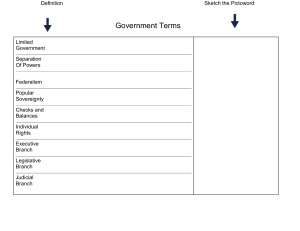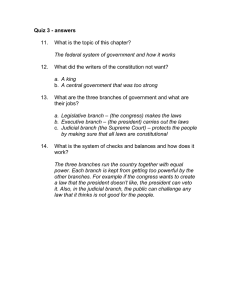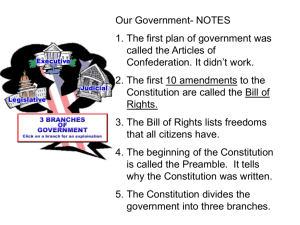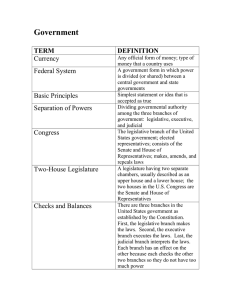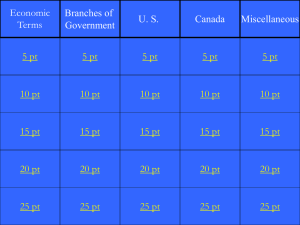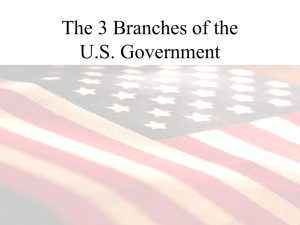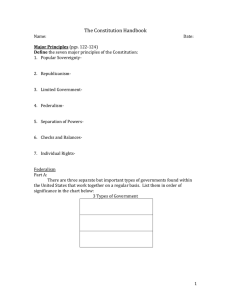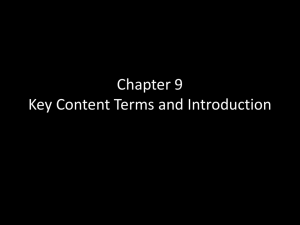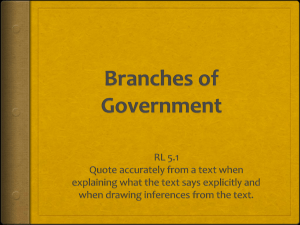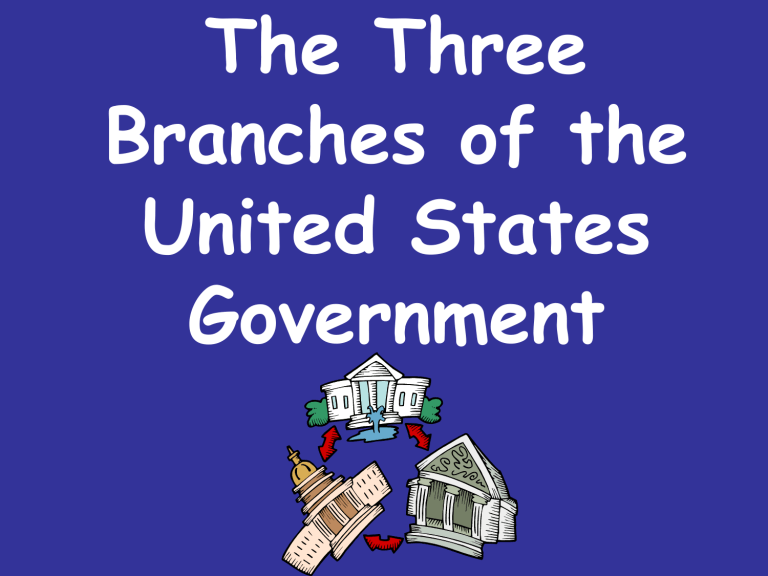
The Three Branches of the United States Government DO NOW • How does the bill making process protect against people abusing power in our government? • Explain how a bill may be passed in a dictatorship. Why would this process be bad for citizens and their basic rights. OUR GOVERNMENT • Constitution: – a document that gives power to the government and rights to the people OUR GOVERNMENT • Checks and Balances – a system that prevents any part of government (branch) from becoming too powerful; • EX) Congress makes bills that the president signs into law • The Constitution divides power among three parts or “branches” of government to ensure no one branch has all the power. – Article 1 = legislative – Article 2 = executive – Article 3 = judicial Legislative Branch • (Makes Laws)Division of the government that proposes and passes bills (includes the House of Representatives and the Senate) Executive Branch • (ENFORCES LAWS)Division of government that includes the president and administrators; enforces laws. Judicial Branch • (INTERPRETS LAWS)Division of government made up of courts; in charge of the court system; interprets laws, punishes criminals and settles disputes (The Supreme Court is the highest court in the United States) SUMMARY OF BRANCHES Senate and House of Repsmake laws President makes laws into reality Supreme Court reviews laws Legislative Branch – Congress MAKES LAWS Legislative – Congress • House of Representatives 1. 2. 3. 4. Reps serve 2 yrs A Rep must be 25 yrs old & a citizen for 7 yrs Can suggest tax laws Can impeach the president Legislative – Congress • Senate 5. Senators serve a 6 yr term 6. A Senator must be 30 yrs old and a citizen for 9 yrs 7. Can approve presidential appointments 8. Approves treaties with foreign powers 9. Can put the president on trial after impeachment Legislative – Congress • Both the House and Senate together 10. Can propose laws 11. Can declare war 12. Can override the president’s veto with a 2/3 vote 13. Can propose amendments to the Constitution with a 2/3 vote Executive Branch – the President ENFORCES LAWS Executive – the President, Vice President and Cabinet 14. The President serves a four year term. 15.The President must be at least 35 yrs old, a 14-yr resident and native born 16. Has the power to approve or veto laws 17. Makes international treaties 18.Nominates judges to the Supreme Ct 19. Appoints cabinet members 20. Is Commander-in-Chief of the military Judicial Branch – Supreme and Federal Courts INTERPRETS LAWS Judicial – Supreme and Federal Courts 21. Justices of the Supreme Ct serve for life 22. Can declare laws unconstitutional 23. Can settle disputes involving the U.S. 24. Can settle disputes between states 25. Chief Justice rules over an impeachment trial of the President Video Questions • How does a bill become a law? • How does this process protect against people abusing power? • What is an executive order? • How could this power be abused? SCENARIO DIRECTIONS • Your group will be given a scenario that deals with checks and balances • Your group must figure out a way to act out the scenario in a 1-2 minute skit for the class • The lines you use in the skit MUST give away – Who you are – Where you are – What you are doing • You will have roughly 5 minutes to come up with a skit – Have fun with it! SCENARIO DIRECTIONS • As you are watching each of your classmates skits, trying to figure out – What branch or branches of government are involved in the skit? – What checks and balances may play a role in the power that is being represented? QUESTIONS • Do you think the systems of checks and balances does a good job of protecting against people abusing power? Give an example • How could someone abuse power under the system of checks and balances and separation of power (three branches)? • Are there any positive or negative aspects to these two systems? Explain. Japanese Internment • Why were Japanese Americans place in prison camps during the 1940s? • What role did the executive branch play in this decision? • How was this action by the government a violation of peoples rights? CLOSING QUESTION • After reading the primary source documents and examining the political cartoon, reflect on the following question; – Explain one or two ways that democracies fall and authoritative governments rise.
